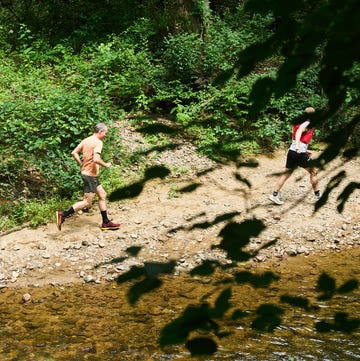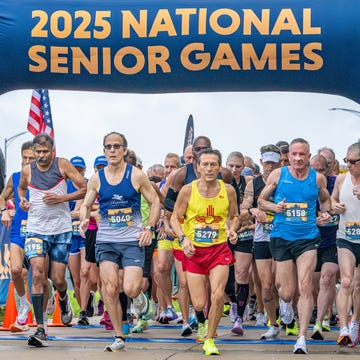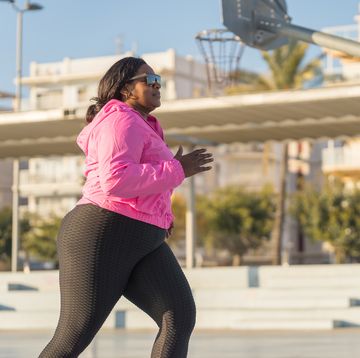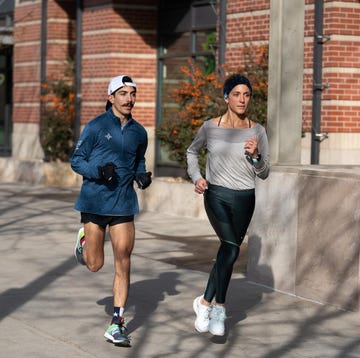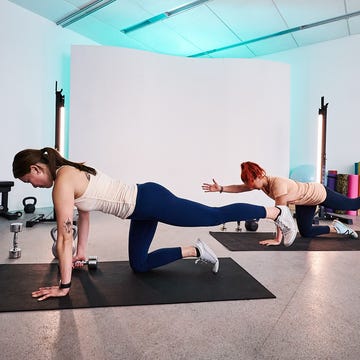Walking is hands down one of the best low-impact workouts out there. Not only is it great for bolstering your bones, boosting your heart health, and bettering your mood, it’s also a stellar form of active recovery for runners.
As exercise physiologist Janet Hamilton, Georgia-based running coach with Running Strong, tells Runner’s World, walking is a gentle-on-the-joints movement that promotes blood flow, which brings nutrients into your muscles and flushes waste products out. This helps your recovery after a tough run. Plus, walking is simple and easy to do. Unlike other recovery activities, such as biking or swimming, you don’t need special equipment or skills to get it done. All you need is a pair of shoes.
However, there are ways to maximize your time spent strolling, and that means embracing brisk walking. Brisk walking provides even more benefits for your heart, muscles, and even mind.
Here, we explain what brisk walking means, what you can gain from adding it to your routine, and experts offer tips on how to amp up the intensity of your strolls.
So, what is brisk walking anyway?
Scientific literature defines brisk walking as a pace of 3 to 4.5 miles per hour, which translates to a 13-minute mile pace, or about 6,000 to 9,000 steps per hour, Jonathan Yu, P.T., D.P.T., a physical therapist at Hospital for Special Surgery in New York City, tells Runner’s World.
Of course, your brisk pace may land outside of these ranges because “brisk” describes a feeling based on how hard you’re working. Just like running pace, walking speed varies because of a bunch of different factors that can make a walk feel like a stroll or like a workout.
One big variable is fitness level, says Yu. A seasoned marathoner, for example, may need to walk at a pace of four miles per hour to reach the brisk threshold, whereas someone who doesn’t exercise regularly may get there with a speed of two miles per hour.
Terrain matters, too: Walk uphill and you’ll achieve brisk status at a lower speed than when you move on flat ground. Even things such as how well rested and hydrated you are, as well as whether you’ve eaten recently, can impact the pace that will make your walk feel brisk, Yu says.
Given all the factors at play, a simpler way to define brisk walking is with perceived exertion—basically, how hard you feel like you’re working. On a scale of one to 10, where one is an extremely easy effort and 10 is all out, brisk walking is in the range of five to six. “Anything that's perceived a moderate intensity, or where you feel like your heart rate is elevated but you can still talk, would fall into the parameters of brisk walking,” Yu says.
An even simpler way to put it is “walking with purpose,” Hamilton says. You are trying to get somewhere, but you aren’t running to get there.
The Benefits of Walking at a Brisk Pace
Say your walks are typically saunters. What perks would you gain from amping the intensity?
Brisk walking stimulates a faster heart rate, which helps strengthen your heart and improves your aerobic fitness, Hamilton says. This can translate to other heart health benefits, including a slower resting heart rate and exercise being less stressful on your system, Yu says. Moreover, as you walk faster, your leg and core muscles have to work harder. That means brisk walks can lead to strength gains in those areas, Yu says. To boot, brisk walking can increase your metabolism, he adds, since you’re burning more energy with each step.
Beyond that, research suggests that people who walk at a brisk pace compared to slow walkers have a lower risk of dying from cardiovascular disease, lower risk of stroke, and lower risk of dementia, among other markers of better health.
And for people who spend a lot of the day sitting, incorporating bursts of brisk walking—as short as 10 minutes per day, every day for a week—can provide a host of benefits, including boosted fitness, improved mood, and a 15 percent lower risk of early death, according to research. If you incorporate longer stretches of brisk walking, say, 30-minute bouts, that can fit the bill for a moderate-intensity workout.
All these benefits come without the impact of running, which is one reason brisk walks are a great lower-intensity alternative to runs, as well as a good form of recovery. This is especially true if you have been injured or need to take a break from running. Similarly, because of this, you should probably not consider brisk walks as a form of cross-training because the benefits are, again, similar to running.
How to Up the Intensity of Your Walks
Ready to add brisk walking to your workout routine? First, make sure you can tolerate walking at a leisurely pace for 30 minutes, Yu advises. If you’re easing back into movement after injury or a long hiatus, work your way up to “brisk” once you’ve established that baseline of walking leisurely for half an hour straight.
From there, incorporate brief intervals of brisk walking into your normal, easy paced stroll. For example, alternate between one-minute brisk walking and four minutes of slower striding, Yu suggests.
Over time, increase the brisk intervals to be longer (say, three minutes) and the leisurely ones to be shorter (think: one minute) until you get to a point where you can complete your full walk at a brisk pace, Yu says.
Keep in mind that this progression should be gradual. You don’t want to jump from a grocery store stroll to a race walking sprint, as that could up your chances of aches and injury. “The trick,” Hamilton says, “is to pick a pace that you can sustain comfortably.”
Besides amping up the speed of your walks, you can push them into brisk category by adding in inclines, either on the treadmill or with a hilly route outdoors. This will deliver an extra strength and power challenge to your muscles—especially your thighs, calves, hips, and core—while also elevating your heart rate, Yu explains. Just make sure you introduce hills gradually so that you don’t strain your legs and low back, Hamilton warns. She suggests starting with rolling hills at a low grade instead of climbing one steep incline the entire time.
Another option, appropriate for more seasoned walkers (i.e., those who have been walking consistently for three to six months) is to carry a weighted backpack. The added heft can bump up the challenge for your muscles, heart, and lungs. As with inclines, take a gradual approach. Yu suggests starting with a five-pound backpack and using that for about three to four weeks before adding another five pounds.
Final piece of advice from the experts: However you approach brisk walking, make it a good time, Hamilton says. For example, pick a route that’s new to you, throw on a motivating playlist, or enlist a friend to join. “Keep it fun and entertaining so that you're more likely to continue doing it over the long haul,” Hamilton explains. That will ensure you reap the amazing benefits of brisk walking for the months—and years—to come.

Jenny is a Boulder, Colorado-based health and fitness journalist. She’s been freelancing for Runner’s World since 2015 and especially loves to write human interest profiles, in-depth service pieces and stories that explore the intersection of exercise and mental health. Her work has also been published by SELF, Men’s Journal, and Condé Nast Traveler, among other outlets. When she’s not running or writing, Jenny enjoys coaching youth swimming, rereading Harry Potter, and buying too many houseplants.






